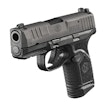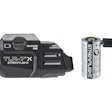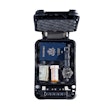Constructed primarily of polymers for weight savings and utilizing a bullpup design to make the weapon as compact as possible, FN introduced its radically different P90 submachine gun in 1990. Chambered for the then-new 5.7 x 28mm cartridge, the original intent of this gun was to provide military and law enforcement with a fast handling PDW (Personal Defense Weapon) capable of penetrating body armor with its lightweight, hypervelocity bullets.
Featuring an innovative 50-round magazine, the P90 offers its users a lightweight and compact weapon, fully ambidextrous, and capable of semi-automatic and full automatic fire. It was lighter and more accurate than any of the many submachine guns chambered for less powerful pistol rounds then in use.
In late 2005 FN introduced the PS90, a semi-automatic version of the P90 submachinegun. This carbine uses a 16.04-inch barrel to make it legal for civilian ownership. I received a sample of the PS90 TR (Triple Rail). This version does not have a reflex sight or iron sights. Instead it has a M1913 Picatinny rail so the user can outfit the weapon with whatever optic the mission requires. There are also two plastic side-rails for mounting lights or lasers. Like the full-auto P90, the PS90 TR is completely ambidextrous and is blowback in operation. The gun also features a downward ejection of empty cases.
But what allows the P90 and PS90 to be so effective yet lightweight is the cartridge that they fire: the 5.7 x 28mm.
CONTROVERSIAL CARTRIDGE
The 5.7 x 28mm cartridge was originally intended for use on the battlefield where most combatants now wear some sort of body armor that pistol calibers are ineffective against. The bottleneck round fires a bullet .224 inches in diameter (5.7mm) and the overall length of the cartridge is 40.5 mm and the case length is 28.7mm. A special polymer coating is applied to the brass cases for easier extraction because of the higher chamber pressures and lack of case taper. This coating also helps the rounds feed more smoothly through the magazine.
Controversy surrounds this relatively new cartridge in regards to its effectiveness and ability to penetrate. Restricted to law enforcement and military sales, the SS190 FMJ round is designed to penetrate body armor and offers the most penetration of any available ammunition. It has a steel penetrator and aluminum core and will easily defeat armor that stops conventional pistol rounds. However, it will not penetrate defenses designed to stop 5.56 x 45mm NATO.
Ballistic gelatin tests reveal that the 31-grain SS190 rounds penetrate between 10 and 13 inches in 10-percent gelatin. Some experts believe that this amount of penetration is insufficient for LE work. Others point to actual shootings and the rounds' propensity to tumble, causing a wound channel equal to the length of the bullet. Individual rounds of 5.7 x 28mm weigh about half of what a 9mm Luger cartridge weighs. FN claims that felt recoil of its cartridge is also about half of the 9mm Luger round. It is more powerful than pistol rounds yet not nearly as powerful as the full size 5.56 NATO cartridge. In fact, the energies generated by the 5.7 x 28mm cartridge are about one-third of those generated by the 5.56 NATO rounds.
FEATURES
One real innovation that the PS90 has is its magazine. My test sample came with one 30-round magazine. I also purchased a 50-round mag for use during the evaluation. The translucent polymer mag sits flat on the top of the receiver just under the optics rail.
Ambidextrous mag releases at the rear of the receiver, when depressed, allow the magazine to be lifted up and out of the carbine. To load the magazine, slide the round under the magazine lips until it locks into position. Loading another round on top flips the cartridge 90 degrees and moves it into the box's storage area where the rounds are held under spring pressure in a staggered, double column.
This is an innovative solution to storing a large number of rounds without adding considerable bulk to the weapon's dimensions. The magazine's see-through construction also makes it easy for the shooter to quickly estimate the number of rounds still left.
One of the big selling features of the PS90 is that the gun is completely ambidextrous. There are cocking handles for charging the chamber on both sides of the carbine. Its safety is unlike anything I have used before and consists of a dial under the trigger that can be easily manipulated with the trigger finger. The safety clicks positively into its "safe" and "fire" positions. The safe position is marked with a white "S" and the fire position is marked with a red "1." I found the safety easy to use and I like its location and design.
You'll note from the pictures that the PS90 has what could best be described as a thumbhole stock. Rather than place a vertical foregrip up front the FN engineers used a rounded area for the support hand with a guard in front of it so the hand doesn't accidentally go forward. That wouldn't be such a big deal on the PS90 with its 16-inch barrel but could prove especially embarrassing with the P-90 full-auto gun with its 10-inch barrel. In any event, the PS90's polymer stock is fast to get into action and comfortable to shoot with.
SHOOTING THE PS90
One thing I discovered is that the PS90's stock design is not exactly compatible with shooting from a bench. There's no real flat area for the carbine to place on the rifle rest and the one thing you don't want to do is shoot a gun for groups with the barrel placed on the rest as it will cause the groups to string vertically. I placed the forward-most portion of the stock on the rifle rest and gingerly balanced the gun. Because of its bullpup design the majority of the carbine's weight is in the rear of the gun. Using a Trijicon TriPower reflex sight I fired a number of groups at 50 yards and was so impressed with the groups that I vowed to return with a scope that had magnification to see what the rifle is really capable of.
Groups with the TriPower measured around 1.5 inches at 50 yards with both of the available ammunition types that I had. On my next outing I removed the TriPower and replaced it with a Trijicon AccuPoint 1.25-4 power scope. Both types of ammunition I tried produced five-shot groups under an inch. I think everyone will agree that the groups this carbine produced are far more accurate than what is needed for a PDW. My test sample's trigger broke at about 7.25 pounds. The PS90's barrel has eight grooves and a 1:9-inch twist and is rifled for 14.8 inches. The barrel terminates in a birdcage flash hider.
I wanted to see if there was any advantage to the 5.7 x 28mm cartridge when compared to the 5.56 x 45mm NATO round in the AR-15 platform. To see just how controllable the PS90 is in rapid fire, I set up a steel target at approximately 30 yards. The target approximates the head and shoulders of a man and is 12 inches wide by 18 inches tall. I used a PACT timer to measure the time between shots as I hammered the target, first with my AR-15 carbine equipped with a Trijicon Reflex sight and then with the PS90 with the Trijicon Tri Power sight installed.
My splits with the AR-15 carbine averaged right around 50/100ths of a second. After switching to the PS90 my splits dropped to 44/100ths of a second. There was noticeably less disruption with my aiming point when firing the 5.7 x 28mm cartridge. The PS90 equipped with the TriPower reflex sight and a loaded magazine weighed about a pound and a half less than my AR-15 carbine outfitted with the reflex sight and loaded 30-round magazine.
DISASSEMBLY
The PS90 is easy to disassemble for cleaning and routine maintenance. Start by removing the magazine and ensuring that the chamber is empty. With the magazine removed from the weapon, push down on the barrel support lock and pull the barrel from the frame. The moving parts group (that's FN nomenclature for the breech block and action springs) can now slide out of the frame. The PS-90's moving parts group is unitized and the breech-block, ejector, extractor, guide rods, and recoil springs can be removed as a single piece.
Make absolutely sure you don't drop the hammer after unloading the gun. Otherwise you will not be able to slide out the moving parts group.
Remove the butt pad by sliding it up and out of the stock. You'll now have access to the hammer group release lever. Lift this lever and remove the unit.
That's as far as the PS90 should be disassembled. Reassembly is in the reverse order. FN's manual suggests that, "the weapon should be cleaned and lubricated after every use or, in the case of intensive shooting, after each 2,000 rounds."
Weighing just 7.5 pounds loaded with 50 rounds and measuring less than 27 inches in length, the PS90 is a lightweight and compact carbine. It possesses a great amount of accuracy and my testing revealed that it was 100-percent reliable.
Mike Detty is an NRA-certified rifle, pistol, and shotgun instructor. A certified rangemaster and competition shooter, Detty served as an officer in the U.S. Marine Corps and holds a degree in criminal justice from the University of Arizona.
FNH Five-seveN
In 2000 FN introduced a companion pistol to its carbine. Like the PS90, the Five-seveN pistol utilizes polymers to create a lightweight gun, which fires the same cartridge as the carbine. Weighing just 1.6 pounds with a fully loaded 20-round magazine, the Five-seveN pistol is a formidable weapon.
There is an accessory rail at the bottom of the Five-seveN's dust cover for attaching lights and/or lasers. While the grip does feel somewhat blocky the gun is not overly bulky. Injected molded checkering and horizontal grooves provide the shooter with a secure firing grip.
Though the Five-seveN's magazine is also constructed from polymer it is of a more conventional design than that of the P-90 and PS-90. Extension kits are available to increase the magazine's capacity to 30 rounds.
Shooting the Five-seveN pistol for accuracy from the bench was a real joy due to its good sights, crisp trigger pull, and light recoil. I was surprised at just how little muzzle lift there was when shooting the pistol and it was easy to print small groups. The trigger pull on my test sample broke at about 5.25 pounds. I don't think that I ever fired a group over 2 inches in size and most were under 1.75 inches with the best measuring a tight 1.27 inches.
I also practiced firing doubletaps with the Five-seveN with my steel targets set up at 12 yards. I found that I could hit the steel with a split, or time between shots, of 45/100ths of a second. That same day I was also testing a full-sized steel framed 1911 in .45 ACP and my times were nearly identical. Though this is comparing apples and oranges, I can say with certainty that the Five-seveN is a very controllable pistol to shoot rapid fire and its recoil is negligible.
The Five-seveN's manual safety levers are located in positions that will be new to most American shooters. Levers are located on both sides of the receiver just above the trigger and can be engaged with the trigger finger or the thumb of your support hand. I was more comfortable flipping the safety down with my left thumb as it rested naturally over the safety with a two-hand hold. The magazine release is also reversible for use by southpaws.
Takedown of the Five-seveN pistol is just as easy as the PS90. Start by removing the magazine and clearing the chamber. Pull the slide back about a quarter of an inch. At the same time push the stripping lever (the most forward gray-colored frame control) completely rearward and hold it in that position as you ease the slide forward off the frame. Holding the slide upside down will allow you to remove the barrel with its recoil spring. There's no reason to disassemble the gun any further for routine maintenance and cleaning.
The Five-seveN makes a great companion pistol for those who use the PS90. It is incredibly lightweight, accurate, and has a great deal of capacity.














